Experienced Bowers look away now!
I have made a few bows in my time; I’ve just finished an ash longbow that I’ll write up about another time. However, I thought some people that may be put off making a self-bow may enjoy having a go at one of these fun stick bows. This one has turned out at only 20Lb at 28 inches draw but it could easily be made heavier. It’s enough to have some fun trying short-range field archery in a wood without fear of arrows going too far; it would also be capable of taking a rabbit at 25m if we were allowed to.
I first made these when I was a kid living in North Africa; descent hardwood branches were few and far between so we had to resort to all sorts of ways of making our bows ranging from drying twisted and bent sticks pegged out in the sun, using bamboo tied together, and joining short sticks together – like the example below.
Many different hardwoods have been used to make bows in Britain for thousands of years including ash, hazel, holly, oak, rowan, hawthorn and wych elm. But, to make a good stick bow with minimum work requires two limbs that taper quite quickly (either that or you’ll have to shave the sticks). Holly saplings are great for this; they taper faster than other saplings so you can make a bow without any shaving at all. On top of that they grow like weeds in the right condition. I have a couple of patches of dense holly growth with nice young straight saplings.
You want two as close to the same size as possible and about 35mm diameter at the widest point; you won’t be making it that thick but it will give you plenty to work with. Trim all the side shoots off but not too close to the main stem; you don’t want to notch that at all.
There’s two schools of thought about peeling the stem: peel it green when it’s easy but dry it slowly oiling it frequently; or dry it and peel it when it’s seasoned (more difficult to do without damaging the stem). Peeling green is easiest but do not try drying it too quick or you will get splits.
When they’re dry (a couple of weeks should do) you can cut the limbs to size. The example below is 6 foot (i.e. two limbs of 3 foot) and they taper from around 25mm diameter to 15mm and it pulls about 20Lb; if you want it heavier you could use thicker lengths of the stems or shorten the bow slightly. You want to cut both limbs with as close to the same diameter as possible and the same length – that may sound impossible, but two saplings taken from the same area will have very similar growth profiles. Carefully carve off all the stem joints; you don’t need or want them flush with the stem but just smooth and tidy.
Now we have to join the two limbs together. As kids we used a variety of methods including just overlapping them side by side and binding, over lapping front and back and binding, and just binding overlapping handles on them. In the one below I’ve drilled 3 inches into each limb and screwed in a piece of 8mm tapped rod, then glued on handles and added a leather binding. As a kid I never had the resources to make anything that complicated. You could make a tidy handle by binding on the handle pieces with paracord.
I finish it with a quick sanding and the application of oil and beeswax.
Have a go and have fun!

Hollies grow like weeds in parts of our wood.
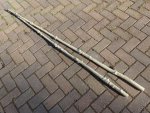
Two saplings peeled and trimmed ready to dry
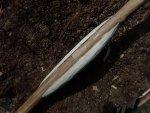
Pinned and handle glued and profiled
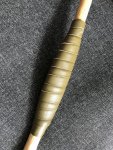
Handle bound with a thin leather strip
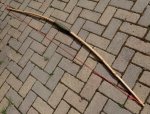
The finished bow (the limbs are the same length honest)
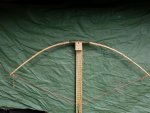
I wouldn't normally tiller a bow of this kind but wanted to see the weight it pulled - it's not a bad shape for two sticks bound together
It's about 20Lb; I could increase that by shortening it - probably an inch each end
I have made a few bows in my time; I’ve just finished an ash longbow that I’ll write up about another time. However, I thought some people that may be put off making a self-bow may enjoy having a go at one of these fun stick bows. This one has turned out at only 20Lb at 28 inches draw but it could easily be made heavier. It’s enough to have some fun trying short-range field archery in a wood without fear of arrows going too far; it would also be capable of taking a rabbit at 25m if we were allowed to.
I first made these when I was a kid living in North Africa; descent hardwood branches were few and far between so we had to resort to all sorts of ways of making our bows ranging from drying twisted and bent sticks pegged out in the sun, using bamboo tied together, and joining short sticks together – like the example below.
Many different hardwoods have been used to make bows in Britain for thousands of years including ash, hazel, holly, oak, rowan, hawthorn and wych elm. But, to make a good stick bow with minimum work requires two limbs that taper quite quickly (either that or you’ll have to shave the sticks). Holly saplings are great for this; they taper faster than other saplings so you can make a bow without any shaving at all. On top of that they grow like weeds in the right condition. I have a couple of patches of dense holly growth with nice young straight saplings.
You want two as close to the same size as possible and about 35mm diameter at the widest point; you won’t be making it that thick but it will give you plenty to work with. Trim all the side shoots off but not too close to the main stem; you don’t want to notch that at all.
There’s two schools of thought about peeling the stem: peel it green when it’s easy but dry it slowly oiling it frequently; or dry it and peel it when it’s seasoned (more difficult to do without damaging the stem). Peeling green is easiest but do not try drying it too quick or you will get splits.
When they’re dry (a couple of weeks should do) you can cut the limbs to size. The example below is 6 foot (i.e. two limbs of 3 foot) and they taper from around 25mm diameter to 15mm and it pulls about 20Lb; if you want it heavier you could use thicker lengths of the stems or shorten the bow slightly. You want to cut both limbs with as close to the same diameter as possible and the same length – that may sound impossible, but two saplings taken from the same area will have very similar growth profiles. Carefully carve off all the stem joints; you don’t need or want them flush with the stem but just smooth and tidy.
Now we have to join the two limbs together. As kids we used a variety of methods including just overlapping them side by side and binding, over lapping front and back and binding, and just binding overlapping handles on them. In the one below I’ve drilled 3 inches into each limb and screwed in a piece of 8mm tapped rod, then glued on handles and added a leather binding. As a kid I never had the resources to make anything that complicated. You could make a tidy handle by binding on the handle pieces with paracord.
I finish it with a quick sanding and the application of oil and beeswax.
Have a go and have fun!

Hollies grow like weeds in parts of our wood.

Two saplings peeled and trimmed ready to dry

Pinned and handle glued and profiled

Handle bound with a thin leather strip

The finished bow (the limbs are the same length honest)

I wouldn't normally tiller a bow of this kind but wanted to see the weight it pulled - it's not a bad shape for two sticks bound together
It's about 20Lb; I could increase that by shortening it - probably an inch each end
Last edited:

